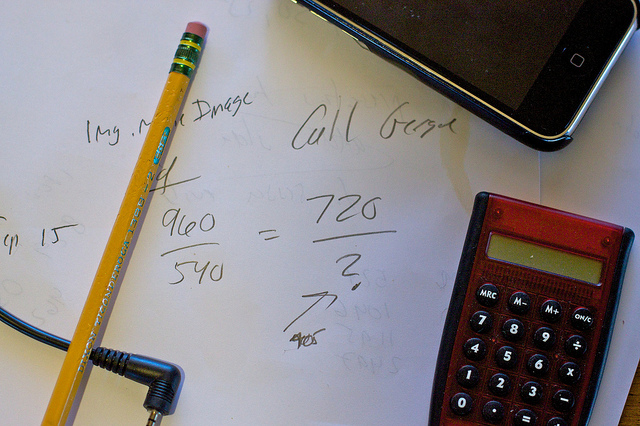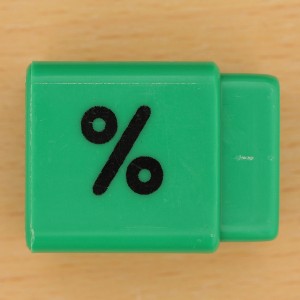Math tips for numerically challenged journalists
For a lot of journalists, dealing with numbers and math can be a little scary. There’s a reason many reporters will say they went into journalism instead of finance or engineering. It’s a love of words and language.
But journalists need to have a grasp of the basics since working reporters deal with math pretty much every day. Numbers make up the foundation of many stories – the municipal project is over of under budget, the politician is some percentage up or down in the polls, violence rates this year are over or below the ten-year average. So there’s really no choice but to get your head around some fundamental math concepts.
onMedia’s Kyle James, for whom math can be a struggle, offers this quick summary of a few calculations you need to know to do your job well and where you can go online to get help when all those numbers just start swimming in your head.
I fell out of love with math early on. It started in elementary school when I had a lot of trouble memorizing the multiplication tables. Then it was kind of downhill from there. The killing blow to the troubled relationship came in high school calculus. Oh, the dread I felt walking in that classroom door every day.
While journalists generally don’t need to know all that much about logarithms and differential equations, we do need to know the most obvious, such as knowing how to add and subtract, multiply and divide. But it’s also important to be able to calculate percentages, find an average, and do a few other things.
Let’s go through some of them here. Don’t worry, I’ll keep it simple enough so even I can understand it.
Percentages
Percentages, representing a part of a whole, make frequent appearances in news stories. They describe relationships between numbers that might be hard to grasp if just the raw data is presented. For example, it’ll be easier for people to understand the results of an election if we report that Sally Smith won almost 56 percent of the vote instead of just writing that she won 14,337 votes out of the 25,689 cast.
Problem: What is 13 percent of 50?
Step 1:
The basic formula is: the percent multiplied by the ‘of’ number = ??
13 percent x 50 = ??
Step 2:
Change the “percent” number into a decimal. To do that, divide the number by 100.
13 / 100 = .13
Step 3:
Do the math laid out in Step 1.
.13 x 50 = 6.5
Answer: 13 percent of 50 is 6.5. Easy, right?
Let’s change it up a little. How can we work out the percentage?
Problem: What percentage of the total vote did Sally Smith get in the election?
Step 1
Calculate the total (the sum) for the category of numbers of your choice (in this case, the total number of votes cast). That’s 25,689.
Step 2
Divide the value of a particular case (votes received by Sally Smith: 14,337) by the total value.
14,337 /25,689 = .558
Step 3
Multiply the result by 100 (or move the decimal point two places to the right) to convert from decimal to percent.
Answer: 55.8 percent.
Not so bad, huh?
Percent Change
Percent change is also often used in news stories, since it helps illustrate how a set of numbers – such as time or prices – has changed over time.
Problem: The price of a yearly bus ticket went up from $110 last year to $125 this year. What percent did the price increase?
Step 1:
The basic formula is (new value – old value) / old value = percent change
(125 – 110) / 110 = ??
Step 2:
Do the math
15 / 110 = .136
Step 3:
Multiply the answer by 100 or move the decimal two places to the right to get the percentage.
Answer: The price went up 13.6 percent.
Averages
Averages present a picture of a group of numbers, giving us a central value or a “central tendency”. When people talk about averages, they’re often lumping a few different things together. Let’s go through the two used mostly in journalism—the mean and the median.
Mean
The mean is the average people are most familiar with. It’s easy to compute. Just add all the numbers up in a group and divide by the number of values in that group.
Problem: What is the average price of a house on Main Street? The five houses on the street cost $125,000, $110,000, $95,000, $105,000 and $120,000?
Step 1: Add the values together.
125,000, 110,000, 95,000, 105,000 and 120,000 = 555,000
Step 2: Divide by the number of values.
555,000 / 5 = 111,000
Answer: The average price of a house on Main Street is $111,000.
Median
But sometimes the mean can be misleading. What if there were one very expensive house on Main Street with a price tag of one million dollars? That “outlier” figure would push the mean much higher, and we wouldn’t have a good representation the general price of most of the houses there.
So in these kinds of instances, you might well want to find or calculate the middle of a collection of numbers containing an extremely high or low value. That’s the median, the middle value in a group of numbers. As an example, let’s use our house prices again.
Problem: What is the median price of a house on Main Street?
Step 1:
Rewrite you list from low-to-high or high-to-low (with the million-dollar house)
$95,000, $105,000, $110,000, $120,000, $125,000, $1,000,000
Step 2:
Take the middle number in the list. That’s your median.
But wait! We’ve got an even number of houses in our list. In this case, we would take the average of the middle two.
Answer: The median here is $115,000.
While these are a few of the most common math tools journalists should be comfortable with, there are more. The Poynter Institute journalism training school lists a few others, such as a familiarity with statistics, ability to calculate percentages, ratios, rates of change, and other relationships between numbers, an understanding of “margin of error” in polling and an ability to translate numbers into terms that your audience can understand.
Some good resources
If you’re stuck, or just want to double-check your work, go to some of the links below to get help or even a refresher course in some basic math concepts.
Statistics Every Writer Should Know. Author Robert Niles has put together a handy that puts basic statistics concepts in plain language.
Math for Journalists: Help with Numbers. Poyner has a free refresher course to get up to speed. Very helpful.
Percent Change Calculator. If you want to double-check your percent change calculation, do it here.
Newsroom Math. Here’s a handy slide show with the basics laid out.
Newsroom math cheat sheet. It’s not all that pretty, but this one page sheet lays out the most common calculations reporters need.
Mathematics Competency Test for Journalists. If you’re feeling confident in your math know-how, here’s a place to test yourself.
Happy calculating.
Written by Kyle James, edited by Kate Hairsine







